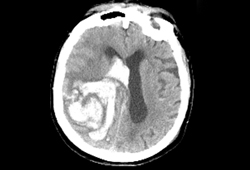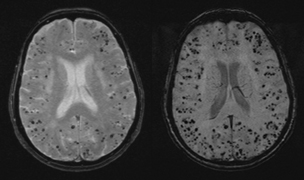Tests
1st tests to order
noncontrast head CT
Test
Most important test, to differentiate hemorrhagic from ischemic stroke.[71][Figure caption and citation for the preceding image starts]: Intracranial hemorrhage on CT scanMassachusetts General Hospital personal case files; used with permission [Citation ends]. Noncontrast CT may also be used as a follow-up exam to evaluate for expansion and worsening mass effect.[13]
Noncontrast CT may also be used as a follow-up exam to evaluate for expansion and worsening mass effect.[13]
May be combined with CT angiography.[9]
Result
hyperdense lesion
chemistry panel
Test
No blood test is available to diagnose stroke.
Chemical analyses rule out conditions mimicking stroke (e.g., hypoglycemia, intoxication, electrolyte disturbances). Abnormal results suggest an alternative cause of symptoms.
Elevated serum glucose is likely a response to the stress and severity of intracranial hemorrhage and is a marker for increased mortality and poor outcome.[9]
Result
normal
CBC
clotting tests
Test
Required to rule out coagulopathy as a cause of hemorrhage.
If elevated, results suggest a secondary cause of hemorrhage.
Consider checking ecarin clotting time in patients taking oral direct thrombin inhibitors.
Consider checking platelet function test in patients taking antiplatelet agents.
Result
usually normal
ECG
Test
Myocardial ischemia may complicate hemorrhagic stroke.
Confused, comatose, or aphasic patients may not be able to verbalize whether they have angina. Large inverted T waves in multiple coronary artery distributions suggest ECG changes of cerebral origin, rather than acute coronary syndrome.[89]
Result
signs of myocardial ischemia, cerebral T waves
platelet function test
Test
Qualitative and quantitative tests have linked platelet aggregation abnormalities to increased risk of early hemorrhagic stroke expansion. More studies are needed to better understand if platelet transfusions can modify this risk.
Result
abnormal platelet aggregation
urine drug screen
Test
Search for sympathomimetic drugs and alcohol abuse can help diagnose the etiology of a hemorrhagic stroke and optimize medical management.[9]
Result
positive or negative
pregnancy test in women of childbearing age
Test
Establishing pregnancy status in women presenting with any type of stroke could significantly alter the medical management of the disease and the pregnancy itself.[9] Peripartum angiopathy, eclampsia, HELLP (hemolysis [H], elevated liver enzymes [EL], and low platelets [LP]) syndrome, and sinus venous thrombosis can cause intracerebral hemorrhage in pregnant women.[9]
Result
positive or negative
liver function test
Test
The presence of significant liver dysfunction can seriously compromise the coagulation system and induce bleeding, and also promote the development of cerebral edema (mainly due to impaired ammonia metabolism) and intracranial hypertension, especially in cases of acute liver failure.
Result
deranged
intracerebral hemorrhage (ICH) score
Test
The most widely used severity-of-illness grading scale for prognosticating outcomes early after onset of intracerebral hemorrhage.
Elements of the ICH Score include: ICH volume (>30 cm² = 1 point); Glasgow Coma Score (GCS) (3-4 = 2 points, 5-12 = 1 point); intraventricular hemorrhage (yes = 1 point); infratentorial ICH location (yes = 1 point); and age (>80 years = 1 point).[25]
Result
score for prognosis after early onset of intracerebral hemorrhage
Tests to consider
CT angiography and venography
Test
Recommended to exclude macrovascular causes of cerebral venous thrombosis in patients with lobar spontaneous intracerebral hemorrhage and age <70 years; or deep/posterior fossa spontaneous intracerebral hemorrhage and age <45 years; or deep/posterior fossa and age 45 to 70 years without history of hypertension.[9]
May be low yield in patients >45 years of age with hypertension and hemorrhages in typical locations (i.e., basal ganglia, thalamus, brain stem, or cerebellum).[90]
Higher spatial resolution than magnetic resonance angiography. CTA has a sensitivity and specificity exceeding 90% compared with catheter arteriography for the identification of secondary causes such as arteriovenous malformation or aneurysm.[13][73][74][75][76]
Presence of "spot sign" (hyperdense contrast material in the hematoma bed on postinjection CT images) associated with greater risk of subsequent hematoma expansion.[13][77][78][79][80][Figure caption and citation for the preceding image starts]: Spot sign on CT angiogram (arrowhead), indicating the presence of hyperdense contrast material within the hematoma bed on postinjection CT; this has been associated with greater risk of subsequent hematoma expansionFoothills Medical Center personal case files; used with permission [Citation ends].
Result
aneurysm, arteriovenous malformation, or cerebral sinus/venous thrombosis
magnetic resonance angiography and venography
Test
Indicated if CT angiography/CT venography cannot be obtained (due to inaccessibility or contrast allergy) or if there is concern about renal impairment. May also be useful to exclude underlying vascular malformations if the etiology is uncertain.[13] Recommended to exclude macrovascular causes of cerebral venous thrombosis in patients with: lobar spontaneous intracerebral hemorrhage and age <70 years; or deep/posterior fossa spontaneous intracerebral hemorrhage and age <45 years; or deep/posterior fossa and age 45 to 70 years without history of hypertension.[9]
May be low yield (the frequency of positive angiography in a defined patient group) in patients >45 years of age with hypertension and hemorrhages in typical locations (i.e., basal ganglia, thalamus, brain stem, or cerebellum).[90]
Result
aneurysm, arteriovenous malformation, or cerebral sinus/venous thrombosis
conventional (invasive) angiography
Test
If there is a high index of suspicion for arteriovenous malformation (AVM), but noninvasive imaging is not diagnostic, conventional invasive angiography is recommended.[9][13] Conventional invasive angiography can demonstrate small AVMs that would otherwise be missed by noninvasive techniques, but its routine use has been supplanted in many centers by safer, noninvasive vessel imaging methods.[13] Recommended in cases with spontaneous intraventricular hemorrhage without intraparenchymal hemorrhage, in order to exclude a macrovascular cause for the hemorrhage.[9] In the acute period, catheter arteriography may miss vascular malformations that are detected by repeat arteriography several weeks later.[13][82]
May be low yield in patients >45 years of age with hypertension and hemorrhages in typical locations (i.e., basal ganglia, thalamus, brain stem, or cerebellum).[90]
Result
aneurysm or AVM
MRI brain
Test
Recommended when certain disease processes are part of the differential diagnosis (e.g., vascular malformation, tumor, cerebral infarction or cerebral sinus/venous thrombosis) that may not be readily apparent on CT.[2][13][83][84] MRI is useful for evaluating alternative etiologies in patients ages <55 years who do not have typical hypertensive hemorrhage.[13][85][83]
Result
aneurysm, arteriovenous malformation, tumor, cerebral sinus/venous thrombosis, cerebral infarction
MRI brain with diffusion-weighted imaging (DWI) and gradient-echo sequence (GRE)
Test
Best performed with GRE sequence and with and without contrast.
Acute ischemic infarct appears bright on DWI.
MRI GRE sequence detects asymptomatic microbleeds in about 5% to 20% of stroke-free older people.
If microbleeds are an incidental finding on MRI, a prompt evaluation for underlying causes and BP control ensues to prevent recurrent intracerebral hemorrhage.[91]
Finding of multiple microbleeds restricted to lobar locations is very suggestive of underlying cerebral amyloid angiopathy.[15]
Sensitivity for hemorrhage equivalent to CT; may allow identification of secondary causes such as infarction, tumor, or cavernous malformation.[92]
In some specialized stroke centers, MRI is the initial imaging of choice.
Result
acute hemorrhage appears hypointense (dark) in gradient-echo
MRI brain with susceptibility-weighted imaging
Test
Susceptibility-weighted imaging (SWI) may be more sensitive for identification of microbleeds and small cerebral cavernous malformations than MRI gradient-echo sequence.[87][Figure caption and citation for the preceding image starts]: 80-year-old woman with numerous punctate foci of hypointensity (black dots) on MRI gradient-echo (GRE) sequence (left), suggesting multiple lobar microbleeds caused by cerebral amyloid angiopathy. MRI susceptibility-weighted imaging (SWI) sequence (right) demonstrates numerous additional microbleeds not seen on the GRE sequenceFoothills Medical Center personal case files; used with permission [Citation ends].
Result
hypointense lesions
Use of this content is subject to our disclaimer